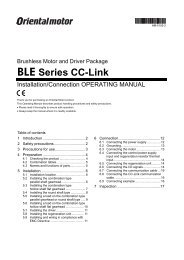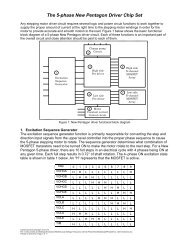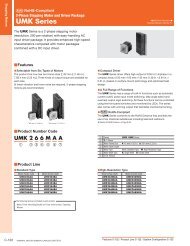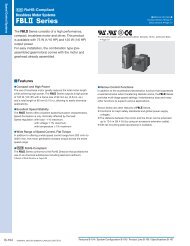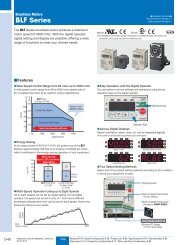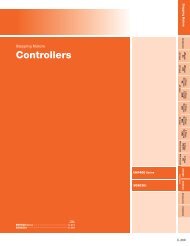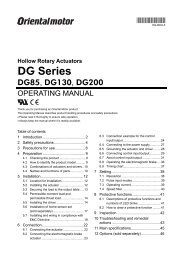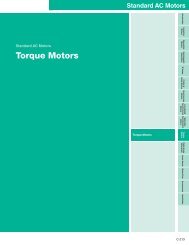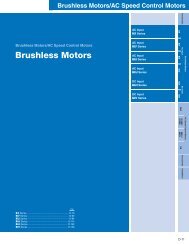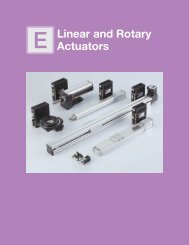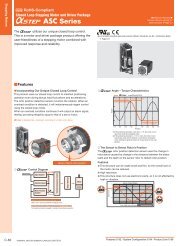Product Reference - Oriental Motor
Product Reference - Oriental Motor
Product Reference - Oriental Motor
You also want an ePaper? Increase the reach of your titles
YUMPU automatically turns print PDFs into web optimized ePapers that Google loves.
Stop Position Accuracy:<br />
The stop position accuracy is the difference between the rotor’s<br />
theoretical stopping position and its actual stopping position. A<br />
given rotor stopping point is taken as the starting point, then the<br />
stop position accuracy is the difference between the maximum (+)<br />
value and maximum (−) value in the set of measurements taken for<br />
each step of a full rotation.<br />
Actual Stopping Position<br />
× ×<br />
× ×<br />
0˚ 0.72˚ 1.44˚ 2.16˚ 2.88˚ 360˚<br />
Theoretical Stopping Position<br />
0.745˚ 1.425˚ 2.17˚ 2.885˚<br />
: Theoretical Stopping Position<br />
× : Actual Stopping Position<br />
The stop position accuracy is within ±3 arc minutes (±0.05˚), but<br />
only under no load conditions. In actual applications there is always<br />
the same amount of friction load.<br />
The angle accuracy in such cases is produced by the angular<br />
displacement caused by the angle – torque characteristics<br />
based upon the friction load. If the friction load is constant, the<br />
displacement angle will be constant for uni-directional operation.<br />
However, in bi-directional operation, double the displacement angle<br />
is produced over a round trip.<br />
When high stopping accuracy is required, always position in the<br />
same direction.<br />
+0.03<br />
Angle Error [deg]<br />
+0.02<br />
+0.01<br />
0<br />
−0.01<br />
−0.02<br />
−0.03<br />
0˚ 0.72˚ 1.44˚ 2.16˚ 2.88˚<br />
Rotation Angle [deg]<br />
Stop Position Accuracy<br />
0.04˚<br />
360°<br />
■Excitation Sequence of Stepping <strong>Motor</strong><br />
and Driver Packages<br />
Every 5-phase motor and driver package listed in our catalog<br />
consists of a New Pentagon, five-lead wire motor and a driver<br />
incorporating a special excitation sequence. This combination, which<br />
is proprietary to <strong>Oriental</strong> <strong>Motor</strong>, offers the following benefits:<br />
· Simple connections for five leads<br />
· Low vibration<br />
The following sections describe the wiring and excitation sequence.<br />
●New Pentagon, 4-Phase Excitation:<br />
Full Step System (0.72˚/step)<br />
This is a system unique to the 5-phase motor, in which four phases<br />
are excited. The step angle is 0.72˚ (0.36˚). It offers a great damping<br />
effect, and therefore stable operation.<br />
VCC<br />
0 V<br />
Pulse Input<br />
+<br />
A Phase 0<br />
−<br />
+<br />
B Phase 0<br />
−<br />
+<br />
C Phase 0<br />
−<br />
+<br />
D Phase 0<br />
−<br />
+<br />
E Phase 0<br />
−<br />
Black<br />
Green<br />
01234567890<br />
Blue<br />
Red<br />
Orange<br />
New Pentagon, 4-Phase Excitation Sequence<br />
Technical <strong>Reference</strong><br />
Selection<br />
Calculations Service Life<br />
Standard<br />
AC <strong>Motor</strong>s<br />
Speed<br />
Control<br />
Systems<br />
Stepping<br />
<strong>Motor</strong>s Gearheads<br />
Linear<br />
Heads<br />
Linear and<br />
Rotary<br />
Actuators Cooling Fans<br />
●New Pentagon, 4-5-Phase Excitation:<br />
Half-Step System (0.36˚/step)<br />
A step sequence of alternating the 4-phase and 5-phase excitation<br />
produces rotation at 0.36˚ per step. One rotation may be divided into<br />
1000 steps.<br />
0 123456789 10 11 12 13 14 15 16 17 18 19 0<br />
Pulse Input<br />
+<br />
A Phase 0<br />
−<br />
+<br />
B Phase 0<br />
−<br />
+<br />
C Phase 0<br />
−<br />
+<br />
D Phase 0<br />
−<br />
+<br />
E Phase 0<br />
−<br />
New Pentagon, 4-5-Phase Excitation Sequence<br />
F-49



